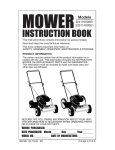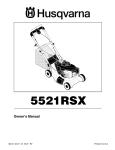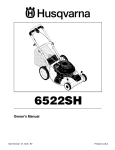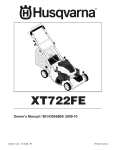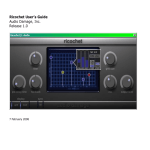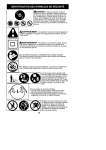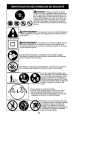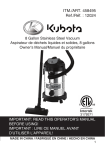Download Poulan 198933 Lawn Mower User Manual
Transcript
MOWER Models 20112X92E0 20112X92E1 INSTRUCTION BOOK This Instruction Book contains information for several models. Read and keep this book for future reference. This book contains important information on SAFETY, ASSEMBLY, OPERATION, MAINTENANCE & STORAGE. PRODUCT INFORMATION The owner must be certain that all the product information is included with the unit. This information includes the INSTRUCTION BOOKS, the REPLACEMENT PARTS and the WARRANTIES. This information must be included to make sure state laws and other laws are followed. RECORD THE FOLLOWING INFORMATION ABOUT YOUR UNIT. THIS INFORMATION IS NECESSARY WHEN ORDERING PARTS OR IN CASE OF LOSS OR THEFT. WHERE PURCHASED: _____________________________ DATE PURCHASED: Month______ Day ______ Year ______ MODEL NO.: _________ DATE OF MANUFACTURE: _________ 198933 04.19.05 BY Printed in U.S.A. TABLE OF CONTENTS Warranty .................................................. 2 Safety Rules ......................................... 3-5 Product Specifications ........................... 5 Assembly/Pre-Operation ...................... 6-8 Operation............................................ 9-11 Maintenance Schedule .......................... 12 Maintenance ..................................... 12-14 Service and Adjustments....................... 15 Storage ............................................. 15-16 Troubleshooting ................................ 16-17 Repair Parts...................................... 18-19 Service .................................... Back Cover WARRANTY The Manufacturer warrants to the original consumer purchaser that this product as manufactured is free from defects in materials and workmanship. For a period of one (1) year from date of purchase by the original consumer purchaser, we will repair or replace, at our option, without charge for parts or labor incurred in replacing parts, any part which we find to be defective due to materials or workmanship. This Warranty is subject to the following limitations and exclusions. 1. This warranty does not apply to the engine, other than EHP manufactured transaxle/ transmission components, battery (except as noted below) or components parts thereof. Please refer to the applicable manufacturer's warranty on these items. 2. Transportation charges for the movement of any power equipment unit or attachment are the responsibility of the purchaser. Transportation charges for any parts submitted for replacement under this warranty must be paid by the purchaser unless such return is requested by Electrolux Home Products. 3. Battery Warranty: On products equipped with a Battery, we will replace, without charge to you, any battery which we find to be defective in manufacture, during the first ninety (90) days of ownership. After ninety (90) days, we will exchange the Battery, charging you 1/12 of the price of a new Battery for each full month from the date of the original sale. Battery must be maintained in accordance with the instructions furnished. 4. The Warranty period for any products used for rental or commercial purposes is limited to 45 days from the date of original purchase. 5. This Warranty applies only to products which have been properly assembled, adjusted, operated, and maintained in accordance with the instructions furnished. This Warranty does not apply to any product which has been subjected to alteration, misuse, abuse, improper assembly or installation, delivery damage, or to normal wear of the product. 6. Exclusions: Excluded from this Warranty are belts, blades, blade adapters, normal wear, normal adjustments, standard hardware and normal maintenance. 7. In the event you have a claim under this Warranty, you must return the product to an authorized service dealer. Should you have any unanswered questions concerning this Warranty, contact: In Canada contact: Electrolux Home Products, Inc. Electrolux Consumer Outdoor Products Outdoor Products Customer Service Dept. 5855 Terry Fox Way 1030 Stevens Creek Road Mississauga, Ontario Augusta, GA 30907 USA L5V 3E4 giving the model number, serial number and date of purchase of your product and the name and address of the authorized dealer from whom it was purchased. THIS WARRANTY DOES NOT APPLY TO INCIDENTAL OR CONSEQUENTIAL DAMAGES AND ANY IMPLIED WARRANTIES ARE LIMITED TO THE SAME TIME PERIODS STATED HEREIN FOR OUR EXPRESSED WARRANTIES. Some areas do not allow the limitation of consequential damages or limitations of how long an implied Warranty may last, so the above limitations or exclusions may not apply to you. This Warranty gives you specific legal rights, and you may have other rights which vary from locale to locale. This is a limited Warranty within the meaning of that term as defined in the Magnuson2 Moss Act of 1975. OWNER'S INFORMATION This instruction book is written for a person with some mechanical ability. Like most service books, not all the steps are described. Steps on how to loosen or tighten fasteners are steps anyone can follow with some mechanical ability. Read and follow these instructions before you use the unit. Know your product: If you understand the unit and how the unit operates, you will get the best performance. As you read this manual, compare the illustrations to the unit. Learn the location and the function of the controls. To help prevent an accident, follow the operating instructions and the safety rules. Keep this manual for future reference. IMPORTANT: Many units are not assembled and are sold in cartons. It is the responsibility of the owner to make sure the assembly instructions in the manual are exactly followed. Other units are purchased in assembled condition. On assembled units, it is the responsibility of the owner to make sure the unit is correctly assembled. The owner must carefully check the unit according to the instructions in this manual before it is first used. RESPONSIBILITY OF THE OWNER The responsibility of the owner is to follow the instructions below. 1. Carefully read and follow the rules for safe operation. 2. Follow all the assembly and preparation instructions. 3. Inspect the unit. 4. Make sure that the operator of the unit knows how to correctly use all standard and accessory equipment. 5. Operate the unit only with guards, shields, and other safety items in place and working correctly. 6. Correctly adjust the unit. 7. Service the unit only with authorized or approved replacement parts. 8. Complete all maintenance on the unit. SAFETY RULES IMPORTANT: This cutting machine is capable of amputating hands and feet and throwing objects. Failure to observe the following safety instructions could result in serious injury or death. Look for this symbol to point out impor tant safety precautions. It means CAUTION!!! BECOME ALERT!!! YOUR SAFETY IS INVOLVED. WARNING: In order to prevent accidental starting when setting up, transporting, adjusting or making repairs, always disconnect spark plug wire and place wire where it cannot come in contact with plug. WARNING: Engine exhaust, some of its constituents, and certain vehicle components contain or emit chemicals known to the State of California to cause cancer and birth defects or other reproductive harm. WARNING: Battery posts, terminals and related accessories contain lead and lead compounds, chemicals known to the State of California to cause cancer and birth defects or other reproductive harm. Wash hands after handling. CAUTION: Muffler and other engine parts become extremely hot during operation and remain hot after engine has stopped. To avoid severe burns on contact, stay away from these areas. 3 I. GENERAL OPERATION • Read, understand, and follow all instructions on the machine and in the manual(s) before starting. Be thoroughly familiar with the controls and the proper use of the machine before starting. • Do not put hands or feet near or under rotating parts. Keep clear of the discharge opening at all times. • Only allow responsible individuals, who are familiar with the instructions, to operate the machine. • Clear the area of objects such as rocks, toys, wire, bones, sticks, etc., which could be picked up and thrown by blade. • Be sure the area is clear of other people before mowing. Stop machine if anyone enters the area. • Do not operate the mower when barefoot or wearing open sandals. Always wear substantial foot wear. • Do not pull mower backwards unless absolutely necessary. Always look down and behind before and while moving backwards. • Never direct discharged material toward anyone. Avoid discharging material against a wall or obstruction. Material may richochet back toward the operator. Stop the blade when crossing gravel surfaces. • Do not operate the mower without proper guards, plates, grass catcher or other safety protective devices in place. • See manufacturer’s instructions for proper operation and installation of accessories. Only use accessories approved by the manufacturer. • Stop the blade(s) when crossing gravel drives, walks, or roads. • Stop the engine (motor) whenever you leave the equipment, before cleaning the mower or unclogging the chute. • Shut the engine (motor) off and wait until the blade comes to complete stop before removing grass catcher. • Mow only in daylight / good artificial light. • Do not operate the machine while under the influence of alcohol or drugs. • Never operate machine in wet grass. Always be sure of your footing: keep a firm hold on the handle; walk, never run. • Disengage the self-propelled mechanism or drive clutch on mowers so equipped before starting the engine. • If the equipment should start to vibrate abnormally, stop the engine (motor) and check immediately for the cause. Vibration is generally a warning of trouble. • Always wear safety goggles or safety glasses with side shields when operating mower. • Be alert and turn machine off if children enter the area. • Before and while walking backwards, look behind and down for small children. • Never allow children to operate the machine. • Use extra care when approaching blind corners, shrubs, trees, or other objects that may obscure vision. IV. SAFE HANDLING OF GASOLINE Use extreme care in handling gasoline. Gasoline is extremely flammable and the vapors are explosive. • Extinguish all cigarettes, cigars, pipes and other sources of ignition. • Use only an approved container. • Never remove gas cap or add fuel with the engine running. Allow engine to cool before refueling. • Never refuel the machine indoors. • Never store the machine or fuel container where there is an open flame, spark or pilot light such as a water heater or on other appliances. • Never fill containers inside a vehicle, on a truck or trailer bed with a plastic liner. Always place containers on the ground away from your vehicle before filling. • Remove gas-powered equipment from the truck or trailer and refuel it on the ground. If this is not possible, then refuel such equipment with a portable container, rather than from a gasoline dispenser nozzle. • Keep the nozzle in contact with the rim of the fuel tank or container opening at all times until fueling is complete. Do not use a nozzle lock-open device. • If fuel is spilled on clothing, change clothing immediately. • Never overfill fuel tank. Replace gas cap and tighten securely. II. SLOPE OPERATION Slopes are a major factor related to slip & fall accidents which can result in severe injury. All slopes require extra caution. If you feel uneasy on a slope, do not mow it. DO: • Mow across the face of slopes: never up and down. Exercise extreme caution when changing direction on slopes. • Remove obstacles such as rocks, tree limbs, etc. • Watch for holes, ruts, or bumps. Tall grass can hide obstacles. DO NOT: • Do not trim near drop-offs, ditches or embankments. The operator could lose footing or balance. • Do not trim excessively steep slopes. • Do not mow on wet grass. Reduced footing could cause slipping. V. GENERAL SERVICE III. CHILDREN Tragic accidents can occur if the operator is not alert to the presence of children. Children are often attracted to the machine and the mowing activity. Never assume that children will remain where you last saw them. • Keep children out of the trimming area and under the watchful care of another responsible adult. 4 • Never run machine inside a closed area. • Never make adjustments or repairs with the engine (motor) running. Disconnect the spark plug wire, and keep wire away from plug to prevent accidental starting. • Keep nuts and bolts, especially blade attachment bolts, tight and keep equipment in good condition. • Never tamper with safety devices. Check their proper operation regularly. • Keep machine free of grass, leaves, or other debris build-up. Clean oil or fuel spillage. Allow machine to cool before storing. • Stop and inspect the equipment if you strike an object. Repair, if necessary, before restarting. • Never attempt to make wheel height adjustments while the engine is running. • Grass catcher components are subject to wear, damage, and deterioration, which could expose moving parts or allow objects to be thrown. Frequently check components and replace with manufacturer’s recommended parts, when necessary. • Mower blades are sharp and can cut. Wrap the blade(s) or wear gloves, and use extra caution when ser vicing them. • Do not change the engine governor setting or overspeed the engine. • Maintain or replace safety and instruction labels, as necessary. WARNING: This lawn mower is equipped with an internal combustion engine and should not be used on or near any unimproved forest-covered, brush-covered or grass-covered land unless the engine’s exhaust system is equipped with a spark arrester meeting applicable local or state laws (if any). If a spark arrester is used, it should be maintained in effective working order by the operator. In the state of California the above is required by law (Section 4442 of the California Public Resources Code). Other states may have similar laws. Federal laws apply on federal lands. A spark arrester for the muffler is available through your nearest authorized service center. PRODUCT SPECIFICATIONS Gasoline Capacity / Type: Oil Capacity: 1.0 Quarts (0,94 Litres) Unleaded Regular 20 Ounces (0,58 Litres) Oil Type (API SG–SL): SAE 30 (above 0°C/32°F); SAE 5W-30 (below 0°C/32°F) Spark Plug: Blade Bolt Torque: Champion RJ19LM (Gap: 0.30" / 0,76 mm) 35-40 ft. lbs. (47-54 N-m) Parts Bag contents (shown full size) Lower Handle Upstop Bracket (4) Hex Head Bolts 3/8-16 x 3/4 (4) Washers (4) Flangelock Nuts Rope Guide (1) Hex Washer Head Self-Tapping Screw #10-24 x 1/2 (1) Locknut 1/4-20 Discharge Guard Upper Handle (2) Hex Head Bolts 1/4-20 (2) Hex Head Bolts 1/4-20 x 1-1/2 (2) Locknuts (2) Nylock (2) Washers Nuts 1/4-20 Wheels (4) Shoulder Bolts (4) Locknuts 3/8-16 (4) Spacers 1" 5 (2) Washers 1-1/4" Parts packed separately in carton Parts Bag Contents (not shown full size) (1) Control Bar (1) Rope Guide (1) Upper Handle (1) Lower Handle (2) Wire Ties (4) Wheels (1) Discharge Guard (1) Engine Zone Control Cable (1) Upstop Bracket ASSEMBLY / PRE-OPERATION CAUTION: Do not operate this mower without the discharge guard or an entire approved grass catcher in place. These guards are for your protection and are required by the American National Standards Institute and Consumer Products Safety Commission. CAUTION: Disconnect spark plug wire from spark plug and place wire where it cannot come in contact with plug. Read these instructions and this manual in its entirety before you attempt to assemble or operate your new lawn mower. IMPORTANT: This lawn mower is shipped WITHOUT OIL OR GASOLINE in the engine. Your new lawn mower has been assembled at the factory with the exception of those parts left unassembled for shipping purposes. All parts such as nuts, washers, bolts, etc., necessary to complete the assembly have been placed in the parts bag. To ensure safe and proper operation of your lawn mower, all parts and hardware you assemble must be tightened securely. Use the correct tools as necessary to ensure proper tightness. TOOLS REQUIRED FOR ASSEMBLY A socket wrench set will make assembly easier. Standard wrench sizes are listed. (1) 5/16" Wrench (1) Adjustable Wrench (1) 7/16" Wrench (1) 9/16" Wrench (1) 1/2" Wrench (1) 3/4" Wrench When right hand or left hand is mentioned in this manual, it means when you are standing in the operating position, behind the handle. UNPACK CARTON 1. Remove all loose parts from carton. 2. Examine all items. Compare with list of unassembled parts and hardware. 3. Remove lawn mower housing with care. Avoid touching blade under housing. Always wear gloves or other protection when working under or lifting mower. ASSEMBLE LOWER HANDLE NOTE: For ease of lower handle assembly, raise rear of mower housing and 6 block securely. ASSEMBLE WHEELS Cutting height is determined by assembling the wheels in one of four possible positions on the mower housing. All wheels must be in the same height position for even cutting. 1. For each wheel, assemble shoulder bolt and spacer as shown. 2. Assemble 1-1/4" diameter washers (rear wheels only) and 3/8-16 locknuts on inside of mower housing and tighten securely. 1. Position lower handle on housing so cut-off flat is forward as shown. 2. Align holes in handle with holes in housing as shown and assemble 3/816 x 3/4 hex bolts, flat washers, and locknuts. Tighten securely. 3. Repeat for opposite side of mower. Flat washers Locknuts Lower handle Hex bolts 1-1/4" diameter Washer (Rear wheels only) Mower housing Shoulder bolt Spacer Cut-off flat forward ASSEMBLE UPPER HANDLE 1. Position upper handle over lower handle with small hole for mounting up-stop bracket to right side and assemble 1/4-20 x 1-1/2 hex bolts and 1/4-20 locknuts. Tighten securely. Wheel 3/8-16 Locknut ASSEMBLE DISCHARGE GUARD 1. Place discharge guard on top of lawn mower discharge opening. 2. Install two (2) 1/4-20 x 3/4 hex bolts through housing and discharge guard. 3. Install two (2) 3/4" diameter washers and two (2) 1/4-20 locknuts. Tighten securely. ASSEMBLE UPSTOP BRACKET 2. Position upstop bracket on the right inside of upper handle as shown. 3. Install the hex washer head screw into the hole in up-stop bracket and upper handle. Tighten securely. AS VIEWED FROM FRONT OF MOWER Up-stop bracket Locknuts Washers Hex bolts Hex washer head screw Discharge guard Lock nuts Hex bolts 7 INSTALL CONTROL BAR 1. Position control bar so flattened section with hole is on opposite side of handle as up-stop bracket. 2. Insert one end of control bar into handle hole on inside of handle. Carefully push in on opposite end of control bar and insert into hole on opposite side of handle. Control bar Up-stop bracket ASSEMBLE ENGINE ZONE CONTROL CABLE TO ENGINE Cable attaches under the brake arm cover, which is opposite the spark plug end of engine. 1. Straighten cable and find the end with the small plastic fitting. 2. Hook the “Z” bend fitting on inner wire of cable into hole in brake arm of engine. 3. Align the tapered end of the small plastic fitting with hole in the mounting bracket and push in until fitting snaps into place. Upper handle Control bar Up-stop bracket Engine zone control cable INSTALL STARTER ROPE 1. Put threaded end of rope guide through hole in side of upper handle above lower handle crossbar. Secure with 1/4-20 locknut. 2. Hold control bar against upper handle and slowly pull engine starter rope out until rope will slip into loop of rope guide. Upper handle Rope guide Locknut “Z” bend cable fitting Lower handle crossbar Brake arm Small plastic fitting Mounting bracket ASSEMBLE ENGINE ZONE CONTROL CABLE TO UPPER HANDLE Assemble cable to opposite side of upstop bracket. 1. Route cable below crossbar of lower handle and up to control bar. 2. Hook “Z” bend fitting on inner wire into hole in control bar. 3. Attach cable fitting to upper handle as shown. 4. Secure cable to lower handle with wire ties. 8 Engine starter rope ASSEMBLE SPARK PLUG BOOT TO SPARK PLUG WIRE 1. Remove spark plug wire from spark plug and install boot to wire. 2. Reconnect spark plug wire to spark plug. Spark plug wire Boot OPERATION KNOW YOUR LAWN MOWER READ THIS OWNER'S MANUAL AND ALL SAFETY RULES BEFORE OPERATING YOUR LAWN MOWER. Compare the illustrations with your lawn mower to familiarize yourself with the location of various controls and adjustments. Save this manual for future reference. These symbols may appear on your lawn mower or in literature supplied with the product. Learn and understand their meaning. Operator presence control bar Engine oil cap with dipstick Starter handle Muffler Air filter Housing Gasoline filler cap Spark plug Discharge guard Primer IMPORTANT: This lawn mower is shipped WITHOUT OIL OR GASOLINE in the engine. MEETS CPSC SAFETY REQUIREMENTS Sears rotary walk-behind power lawn mowers conform to the safety standards of the American National Standards Institute and the U.S. Consumer Product Safety Commission. The blade turns when the engine is running. Primer – pumps additional fuel from the Operator presence control bar – must carburetor to the cylinder for use when be held down to the handle to start the starting a cold engine. engine. Release to stop the engine. Starter handle – used for starting engine. 9 BEFORE STARTING ENGINE The operation of any lawn mower can result in foreign objects thrown into the eyes, which can result in severe eye damage. Always wear safety glasses or eye shields while operating your lawn mower or performing any adjustments or repairs. We recommend standard safety glasses or a wide vision safety mask worn over spectacles. ADD OIL Your lawnmower is shipped without oil in the engine. For type and grade of oil to use, see “ENGINE” in the Maintenance section of this manual. CAUTION: DO NOT overfill engine with oil, or it will smoke heavily from the muffler on startup. 1. Be sure lawnmower is level. 2. Remove oil dipstick from oil fill spout. 3. You receive a container of oil with the unit. Slowly pour the entire container down the oil fill spout into the engine. NOTE: Initial oil fill requires only 18 oz. due to residual oil in engine from the manufacturers 100% quality testing. When changing oil you may need 20 oz. 4. Insert and tighten dipstick. IMPORTANT: • Check oil level before each use. Add oil if needed. Fill to full line on dipstick. • Change the oil after every 25 hours of operation or each season. You may need to change the oil more often under dusty, dirty conditions. See “TO CHANGE ENGINE OIL” in the Maintenance section of this manual. HOW TO USE YOUR LAWN MOWER ENGINE SPEED Engine speed was set at the factory for optimum performance. It is not adjustable. ENGINE ZONE CONTROL CAUTION: Federal regulations require an engine control to be installed on this lawn mower in order to minimize the risk of blade contact injury. Do not under any circumstances attempt to defeat the function of the operator control. The blade turns when the engine is running. • Your lawn mower is equipped with an operator presence control bar which requires the operator to be positioned behind the lawn mower handle to start and operate the lawn mower. Gasoline filler cap TO ADJUST CUTTING HEIGHT Raise wheels for low cut and lower wheels for high cut, adjust cutting height to suit your requirements. Medium position is best for most lawns. 1. Remove wheel, bolt, and hardware and reassemble in desired adjustment hole. 2. Reinstall wheel components in the same order as they were before removal. Tighten securely. Engine oil cap Primer Spacer Wheel Bolt 3/8-16 Locknut 10 ADD GASOLINE • Fill fuel tank to bottom of tank filler neck. Do not overfill. Use fresh, clean, regular unleaded gasoline with a minimum of 87 octane. Do not mix oil with gasoline. Purchase fuel in quantities that can be used within 30 days to assure fuel freshness. CAUTION: Wipe off any spilled oil or fuel. Do not store, spill or use gasoline near an open flame. CAUTION: Alcohol blended fuels (called gasohol or using ethanol or methanol) can attract moisture which leads to separation and formation of acids during storage. Acidic gas can damage the fuel system of an engine while in storage. To avoid engine problems, the fuel system should be emptied before storage of 30 days or longer. Empty the gas tank, start the engine and let it run until the fuel lines and carburetor are empty. Use fresh fuel next season. See Storage Instructions for additional information. Never use engine or carburetor cleaner products in the fuel tank or permanent damage may occur. TO STOP ENGINE • To stop engine, release operator presence control bar. TO START ENGINE NOTE: Due to protective coatings on the engine, a small amount of smoke may be present during the initial use of the product and should be considered normal. 1. To start a cold engine, push primer three (3) times before trying to start. Use a firm push. This step is not usually necessary when starting an engine which has already run for a few minutes. 2. Hold operator presence control bar down to the handle and pull starter handle quickly. Do not allow starter rope to snap back. NOTE: In cooler weather it may be necessary to repeat priming steps. In warmer weather over priming may cause flooding and engine will not start. If you do flood engine, wait a few minutes before attempting to start and do not repeat priming steps. MOWING TIPS CAUTION: Do not use de-thatcher blade attachments on your mower. Such attachments are hazardous, will damage your mower and could void your warranty. • Under certain conditions, such as very tall grass, it may be necessary to raise the height of cut to reduce pushing effort and to keep from overloading the engine and leaving clumps of grass clippings. It may also be necessary to reduce ground speed and/or run the lawn mower over the area a second time. • For extremely heavy cutting, reduce the width of cut by overlapping previously cut path and mow slowly. • For side discharge lawn mowers, cutting in a counter-clockwise direction, starting at the outside of the area to be cut, spreads grass clippings more evenly and puts less load on the engine. To keep clippings off of walkways, flower beds, etc., make the first cuts in a clockwise direction. • Keep top of engine around starter clear and clean of grass clippings and chaff. This will help engine air flow and extend engine life. 11 MAINTENANCE BEFORE EACH USE AFTER EACH USE EVERY 10 HOURS EVERY 25 HOURS OR SEASON EVERY 100 HOURS BEFORE STORAGE Check for Loose Fasteners Clean / Inspect Grass Catcher * Check Tires Check Drive Wheels *** Clean Lawn Mower **** Clean under Drive Cover *** Check Drive Belt / Pulleys *** Check / Sharpen / Replace Blade Lubrication Clean and Recharge Battery ** Check Engine Oil level Change Engine Oil Clean Air Filter Inspect Muffler Replace Spark Plug Replace Air Filter Paper Cartridge Empty fuel system or add Stabilizer * (if so equipped) ** Electric-Start mowers *** Power-Propelled mowers a scraper **** Use to clean under deck 1 - Change more often if operating under a heavy load or in high outdoor temperatures. 2 - Service more often if operating in dirty or dusty conditions. 3 - Replace blades more often when mowing in sandy soil. 4 - Charge 48 hours at end of season. 5 - And after each 5 hours of use. LUBRICATION CHART GENERAL RECOMMENDATIONS The warranty on this lawn mower does not cover items that have been subjected to operator abuse or negligence. To receive full value from the warranty, operator must maintain unit as instructed in this manual. ➁ Engine oil Some adjustments will need to be made periodically to properly maintain your unit. At least once a season, check to see if you should make any of the adjustments described in the Service and Adjustments section of this manual. • At least once a year, replace the spark plug, clean or replace air filter element and check blade for wear. A new spark plug and clean/new air filter element assure proper air-fuel mixture and help your engine run better and last longer. • Follow the maintenance schedule in this manual. ➀ Discharge guard hinge pin ➀ Spray lubricant ➁ See "ENGINE" in Maintenance section. BEFORE EACH USE • Check engine oil level. • Check for loose fasteners. LUBRICATION Keep unit well lubricated (See “LUBRICATION CHART”). 12 IMPORTANT: Do not oil or grease plastic wheel bearings. Viscous lubricants will attract dust and dirt that will shorten the life of the self-lubricating bearings. If you feel they must be lubricated, use only a dry, powdered graphite type lubricant sparingly. LAWN MOWER Blade adapter Always observe safety rules when performing any maintenance. Lockwasher TIRES • Keep tires free of gasoline, oil, or insect control chemicals which can harm rubber. • Avoid stumps, stones, deep ruts, sharp objects and other hazards that may cause tire damage. BLADE CARE For best results, blade must be kept sharp. Replace a bent or damaged blade. CAUTION: Use only a replacement blade approved by the manufacturer of your mower. Using a blade not approved by the manufacturer of your mower is hazardous, could damage your mower and void your warranty. TO REMOVE BLADE 1. Disconnect spark plug wire from spark plug and place wire where it cannot come in contact with plug. 2. Turn lawn mower on its side. Make sure air filter and carburetor are up. 3. Use a wood block between blade and mower housing to prevent blade from turning when removing blade bolt. NOTE: Protect your hands with gloves and/or wrap blade with heavy cloth. 4. Remove blade bolt by turning counterclockwise. 5. Remove blade and attaching hardware (bolt, lock washer, hardened washer). NOTE: Remove the blade adapter and check the key inside hub of blade adapter. The key must be in good condition to work properly. Replace adapter if damaged. Key Crankshaft keyway Blade Blade bolt Hardened washer Trailing edge Crankshaft TO SHARPEN BLADE NOTE: We do not recommend sharpening blade - but if you do, be sure the blade is balanced. Care should be taken to keep the blade balanced. An unbalanced blade will cause eventual damage to mower or engine. • The blade can be sharpened with a file or on a grinding wheel. Do not attempt to sharpen while on the mower. • To check blade balance, drive a nail into a beam or wall. Leave about one inch of the straight nail exposed. Place center hole of blade over the head of the nail. If blade is balanced, it should remain in a horizontal position. If either end of the blade moves downward, sharpen the heavy end until the blade is balanced. ENGINE LUBRICATION Use only high quality detergent oil rated with API service classification SG–SL. Select the oil's SAE viscosity grade according to your expected operating temperature. SAE VISCOSITY GRADES SAE 30 TO REPLACE BLADE 5W-30 1. Position the blade adapter on the en-20 0 30 100 32 40 80 60 F gine crankshaft. Be sure key in adapter -20 0 C -30 10 20 30 40 -10 TEMPERATURE RANGE ANTICIPATED BEFORE NEXT OIL CHANGE and crankshaft keyway are aligned. 2. Position blade on the blade adapter NOTE: Although multi-viscosity oils aligning the two (2) holes in the blade (5W30, 10W30 etc.) improve starting in with the raised lugs on the adapter. 3. Be sure the trailing edge of blade (oppo- cold weather, these multi-viscosity oils will result in increased oil consumption when site sharp edge) is up toward engine. used above 32°F. Check your engine oil 4. Install the blade bolt with the lock level more frequently to avoid possible washer and hardened washer into engine damage from running low on oil. blade adapter and crankshaft. Change the oil after every 25 hours of 5. Use block of wood between blade and operation or at least once a year if the lawn mower housing and tighten the lawn mower is not used for 25 hours in blade bolt, turning clockwise. one year. • The recommended tightening torque is Check the crankcase oil level before 35-40 ft. lbs. / 47-54 N-m. starting the engine and after each five (5) IMPORTANT: Blade bolt is heat treated. hours of continuous use. Tighten oil plug If bolt needs replacing, replace only with securely each time you check the oil level. approved bolt shown in the Repair Parts section of this manual. 13 Screw TO CHANGE ENGINE OIL 1. Disconnect spark plug wire from spark plug and place wire where it cannot come in contact with plug. 2. Be sure lawn mower is on level surface. NOTE: Oil will drain more freely when warm. Catch oil in a suitable container. 3. Remove bottom oil drain plug. 4. After oil has drained completely, replace oil drain plug and tighten securely. 5. Fill engine with oil. (See “ADD OIL” in the Operation section of this manual). 6. Reconnect spark plug wire to spark plug. Lip ASSEMBLE ONE OF THESE LOW POINTS TOWARDS NARROW EDGE OF ELEMENT Element Cup Body ASSEMBLE SO LIP EXTENDS OVER EDGE OF AIR CLEANER BODY LIP WILL FORM PROTECTIVE SEAL WHEN COVER IS ASSEMBLED MUFFLER Inspect and replace corroded muffler as it could create a fire hazard and/or damage. SPARK PLUG Replace spark plug at the beginning of each mowing season or after every 100 hours of operation, whichever occurs first. Spark plug type and gap setting are shown in the “PRODUCT SPECIFICATIONS” section of this manual. Drain plug AIR FILTER Your engine will not run properly and may be damaged by using a dirty air filter. Clean the element after every 25 hours of operation or every season. Replace the air filter every 100 hours of operation or every season, whichever occurs first. Service air cleaner more often under dusty conditions. TO CLEAN AIR FILTER ELEMENT 1. Remove screw. 2. Remove air cleaner carefully to prevent dirt from entering carburetor. 3. Take air cleaner apart and clean air filter element. 4. Wash filter element in liquid detergent and water. 5. Wrap filter element in cloth and squeeze dry. 6. Lightly coat filter element with clean engine oil. Squeeze in towel to remove excess oil. Do not saturate. 7. Reassemble parts and put back on carburetor. 14 CLEANING IMPORTANT: For best performance, keep mower housing free of built-up grass and trash. Clean the underside of your mower after each use. CAUTION: Disconnect spark plug wire from spark plug and place wire where it cannot come in contact with plug. • Clean the underside of your lawn mower by scraping to remove build-up of grass and trash. • Clean engine often to keep trash from accumulating. A clogged engine runs hotter and shortens engine life. • Keep finished surfaces and wheels free of all gasoline, oil, etc. • We do not recommend using a garden hose to clean lawn mower unless the electrical system, muffler, air filter and carburetor are covered to keep water out. Water in engine can result in shortened engine life. SERVICE AND ADJUSTMENTS WARNING: To avoid serious injury, before performing any service or adjustments: 1. Release control bar and stop engine. 2. Make sure the blade and all moving parts have completely stopped. 3. Disconnect spark plug wire from spark plug and place wire where it cannot come in contact with plug. LAWN MOWER ENGINE TO ADJUST CUTTING HEIGHT See “TO ADJUST CUTTING HEIGHT” in the Operation section of this manual. ENGINE SPEED Your engine speed has been factory set. Do not attempt to increase engine speed or it may result in personal injury. If you believe that the engine is running too fast or too slow, take your lawn mower to a qualified service center for repair and adjustment. REAR DEFLECTOR The rear deflector, attached between the rear wheels of your mower, is provided to minimize the possibility that objects will be thrown out of the rear of the mower into the operator mowing position. If the deflector becomes damaged, it should be replaced. CARBURETOR Your carburetor is not adjustable. If your engine does not operate properly due to suspected carburetor problems, take your lawn mower to a qualified service center for repair or adjustment. IMPORTANT: Never tamper with the engine governor, which is factory set for proper engine speed. Overspeeding the engine above the factory high speed setting can be dangerous. If you think the engine-governed high speed needs adjusting, contact a qualified service center, which has proper equipment and experience to make any necessary adjustments. DISCHARGE GUARD The discharge guard, attached to the discharge opening of your lawn mower, is provided to prevent the possibility of injury resulting from objects being thrown out of the discharge opening into the operator mowing position. If the discharge guard becomes damaged, it should be replaced. STORAGE Immediately prepare your lawn mower for storage at the end of the season or if the unit will not be used for 30 days or more. LAWN MOWER ENGINE When lawn mower is to be stored for a period of time, clean it thoroughly, remove all dirt, grease, leaves, etc. Store in a clean, dry area. 1. Clean entire lawn mower (See “CLEANING” in the Maintenance section of this manual). 2. Lubricate as shown in the Maintenance section of this manual. 3. Be sure that all nuts, bolts, screws, and pins are securely fastened. Inspect moving parts for damage, breakage and wear. Replace if necessary. 4. Touch up all rusted or chipped paint surfaces; sand lightly before painting. FUEL SYSTEM IMPORTANT: It is important to prevent gum deposits from forming in essential fuel system parts such as carburetor, fuel filter, fuel hose or tank during storage. Alcohol blended fuels (called gasohol or using ethanol or methanol) can attract moisture which leads to separation and formation of acids during storage. Acidic gas can damage the fuel system of an engine while in storage. • Empty the fuel tank by starting the engine and letting it run until the fuel lines and carburetor are empty. • Never use engine or carburetor cleaner products in the fuel tank or permanent damage may occur. • Use fresh fuel next season. 15 OTHER NOTE: Fuel stabilizer is an acceptable alternative in minimizing the formation of fuel gum deposits during storage. Add stabilizer to gasoline in fuel tank or storage container. Always follow the mix ratio found on stabilizer container. Run engine at least 10 minutes after adding stabilizer to allow the stabilizer to reach the carburetor. Do not empty the gas tank and carburetor if using fuel stabilizer. • Do not store gasoline from one season to another. • Replace your gasoline can if your can starts to rust. Rust and/or dirt in your gasoline will cause problems. • If possible, store your unit indoors and cover it to protect it from dust and dirt. • Cover your unit with a suitable protective cover that does not retain moisture. Do not use plastic. Plastic cannot breathe, which allows condensation to form and will cause your unit to rust. IMPORTANT: Never cover mower while engine and exhaust areas are still warm. CAUTION: Never store the lawn mower with gasoline in the tank inside a building where fumes may reach an open flame or spark. Allow the engine to cool before storing in any enclosure. ENGINE OIL Drain oil (with engine warm) and replace with clean engine oil. (See “ENGINE” in the Maintenance section of this manual). CYLINDER 1. Remove spark plug. 2. Pour 29 ml of oil through spark plug hole into cylinder. 3. Pull starter handle slowly a few times to distribute oil. 4. Replace with new spark plug. TROUBLESHOOTING - See appropriate section in manual unless directed to a qualified service center. PROBLEM Does not start CAUSE CORRECTION 1. Dirty air filter. 2. Out of fuel. 3. Stale fuel. 4. Water in fuel. 5. Spark plug wire is disconnected. 6. Bad spark plug. 7. Loose blade or broken blade adapter. 8. Control bar in released position. 9. Control bar defective. 10. Fuel valve lever (if so equipped) in OFF position. 11. Weak battery (if equipped). 12. Disconnected battery connector (if equipped). 16 1. Clean/replace air filter. 2. Fill fuel tank. 3. Empty fuel tank and refill tank with fresh, clean gasoline. 4. Empty fuel tank and refill tank with fresh, clean gasoline. 5. Connect wire to plug. 6. Replace spark plug. 7. Tighten blade bolt or replace blade adapter. 8. Depress control bar to handle. 9. Replace control bar. 10. Turn fuel valve lever to the ON position. 11. Charge battery. 12. Connect battery to engine. TROUBLESHOOTING - See appropriate section in manual unless directed to a qualified service center. PROBLEM Loss of power Poor cut – uneven CAUSE CORRECTION 1. Rear of mower housing or blade dragging in grass. 2. Cutting too much grass. 3. Dirty air filter. 4. Buildup of grass, leaves, and trash under mower. 5. Too much oil in engine. 6. Walking speed too fast. 1. Worn, bent or loose blade. 2. Wheel heights uneven. 3. Buildup of grass, leaves and trash under mower. Excessive vibration 1. Worn, bent or loose blade. 2. Bent engine crankshaft. 1. Raise cutting height. 2. Raise cutting height. 3. Clean/replace air filter. 4. Clean underside of mower housing. 5. Check oil level. 6. Cut at slower walking speed. 1. Replace blade. Tighten blade bolt. 2. Set all wheels at same height. 3. Clean underside of mower housing. 1. Replace blade. Tighten blade bolt. 2. Contact a qualified service center. Starter rope hard to pull 1. Engine flywheel brake is on 1. Depress control bar to when control bar is released. upper handle before pulling the starter rope. 2. Bent engine crankshaft. 2. Contact a qualified service center. 3. Blade adapter broken. 3. Replace blade adapter. 4. Blade dragging in grass. 4. Move lawn mower to cut grass or to hard surface. Grass catcher not filling (If so equipped) 1. Cutting height too low. 2. Lift on blade worn off. 3. Catcher not venting air. 1. Raise cutting height. 2. Replace blade. 3. Clean grass catcher. Hard to push 1. Grass is too high or wheel height is too low. 2. Rear of mower housing or blade dragging in grass. 3. Grass catcher too full. 4. Handle height position not right for you. 1. Raise cutting height. 17 2. Raise rear of mower housing one (1) setting higher. 3. Empty grass catcher. 4. Adjust handle height to suit. ¨ PARTS AND SERVICE This product has been expertly engineered and carefully manufactured to rigid quality standards. As with all mechanical products, some adjustments or part replacement may be necessary during the life of your unit. For Parts and Service, contact our authorized distributor: call 1-800-849-1297 • For replacement parts, have available the following information: a. Model Number / Manufacturer's I.D. Number b. Description of part. For Technical Assistance: call 1-800-829-5886


















